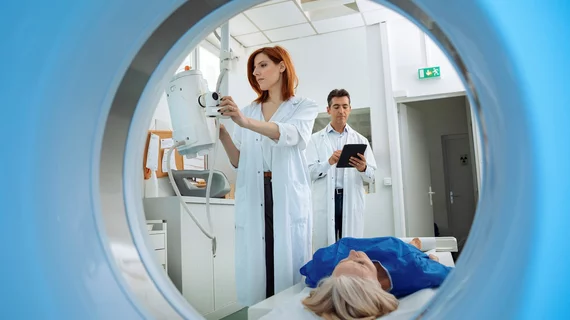Radiologists must ensure these 6 things don’t push them ‘back into relative invisibility’
Radiology’s role in healthcare may be at its peak, with advanced diagnostic tools and interventional care making the field indispensable.
At the same time, imaging providers must be wary of resting on their laurels, one Irish radiologist warned Wednesday in an editorial published by European Radiology. The field needs to consider that the very advances that earned them visibility could also send them back into obscurity.
“We have spent many decades striving to bring radiology to the center of patient care,” Adrian P. Brady, of Mercy University Hospital in Cork, Ireland, wrote Feb. 10. “And yet, there are dangers that radiology may retreat or be pushed back into relative invisibility, and potential consequent peripherality. Our technological innovations may ultimately work against us,” Brady, also a vice president at the European Society of Radiology, added.
With this in mind, below are six things radiologists need to consider.
1. Artificial intelligence: If there are still radiologists who believe AI will replace them, they need to move past those fears (many experts say this narrative has been overblown). It’s clear algorithms will change the field, but rads must ensure they remain central to how AI is used within imaging. Understanding it, deploying it safely and making sure everyone is on the same page are all key.
2. PACS and voice-recognition tools: Prior to these advances, referring clinicians looking for urgent reports had to visit the radiology department. Now those delays are gone, and for the better, Brady explained. But rads need to avoid becoming anonymous rapid report delivery vehicles that reduce their direct interaction with colleagues and turn them into hamsters running on a wheel.
3. Teleradiology: Remote reading enables instant access to subspecialists and ensures isolated regions receive equitable care. Teleradiology also puts distance between radiologists and both referrers and patients, potentially reducing rads’ value from direct participants in care to report-pushing bystanders. Payers and referrers need to know telework is an adjunct, not a substitute, for traditional imaging services.
4. Structured reporting: Some radiologists object to the constraints of structured reporting, but the authors believe its benefits are “too strong to resist.” This new style may seem like another “investigative output” to some, but rads have to emphasize that their input goes beyond what’s contained in structure documents.
5. Communication: Younger radiologists are more comfortable with electronic communication than older providers, yet there’s still no replacing “good old-fashioned face-to-face” discussion to solve a problem. It’s also easier to lose the benefit of human interaction online, Brady noted.
6. COVID-19: Speaking of face-to-face interactions, the novel virus has upended traditional communication, forcing radiologists off-site or behind closed doors. Remote interactions made sense early on, but this way of working cannot become the norm, Brady explained.
“So, however much our technology, work circumstances and inclinations may conspire, let us not allow ourselves become the recluses of medicine,” Brady closed. “By being aware of the risks and dangers of invisibility, we can mitigate them, and continue to represent our specialty positively, and in plain sight.”

